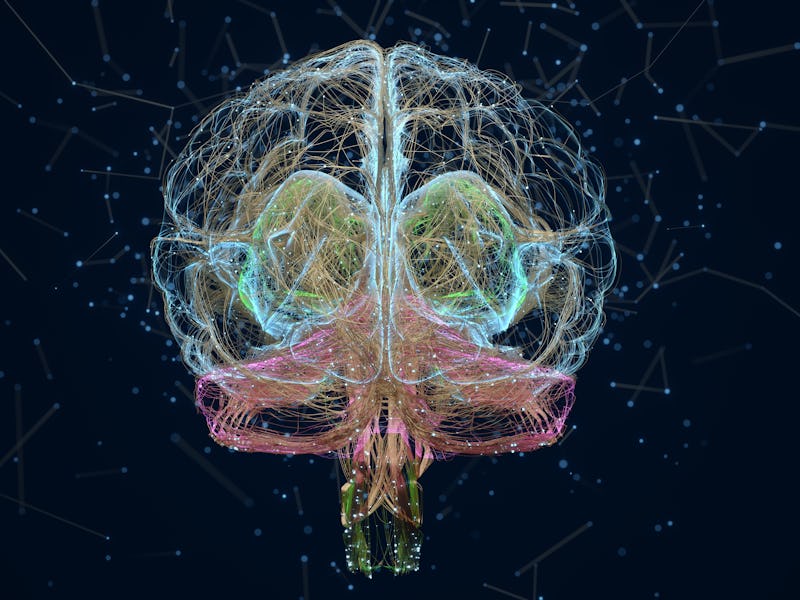Why your brain may be "sleeping" when your eyes are wide open
A new understanding of sleep may explain why the mind wanders.

The classical idea of sleep is that it's an all-or-nothing phenomenon. If someone is responsive, they are awake. If they are not awake, they are in snooze-town.
This concept is bolstered by what we observe in the brain. Tests that detect electrical activity show this activity looks different during wakefulness and sleep, and especially during deep sleep. Slow wave activity is most common during our deepest moments of slumber, a beating rhythm of neurons linked to memory and learning consolidation.
But this view of one of, if not the most, quintessential parts of life is changing. Recent research suggests various parts of the brain can be in different sleep states, regardless of whether a person is, from a behavioral perspective, awake or asleep.
This idea lends itself to an emerging concept — the phenomenon of “local sleep,” explored by Thomas Andrillon and colleagues in a study recently published in the journal Nature Communications.
During local sleep, brains can show signs of the slow waves seen in deep sleep despite the person whose cranium holds that brain being awake. This study suggests slow waves during waking hours may predict when the mind wanders or when it goes blank.
It also means the relationship between sleep and consciousness is more tangled than previously realized.
“Sleep, from a brain perspective, is a complex, multifaceted phenomenon,” Andrillon, a research fellow at the Paris Brain Institute and Monash University, tells me.
“In particular, sometimes, different parts of the brain can be in different wake or sleep states. The boundary between wake and sleep is therefore far more fluid than previously thought.”
Searching for slow waves
When your mind goes blank, it means you’re awake but feel empty of mind; your stream of consciousness has come to a halt. Mind-wandering, meanwhile, is when your focus drifts to thoughts unrelated to the task at hand — like when you’re thinking about what you should have said during an argument earlier in the day while you’re answering emails at night.
“Why do we spend so much time not paying attention to our environment?”
Daydreaming, Andrillon says, is a form of mind-wandering, but it is also “fundamentally different.” Daydreaming is more elaborate than most mind-wandering, and its neural mechanisms could be quite distinct, too. He should know: “I am a frequent, and perhaps too frequent, daydreamer.”
Andrillon’s academic interest in both daydreaming and mind-wandering is rooted in longstanding questions like: Why do we spend so much time not paying attention to our environment? What happens in the brain during these moments?
To determine the answers to these questions and more, Andrillon and colleagues recruited 26 people and recorded their whole brain electrical activity while they completed a boring task for almost two hours. Every 30 to 70 seconds, the researchers interrupted the participants and asked them whether their mental state was mind-wandering, mind-blanking, or task-focused — as well as how tired they were.
The idea here, Andrillon explains, is that mind-wandering, for example, “could be associated with parts of the brain sleeping while the rest is awake,” Andrillon says.
Mind-wandering “could be associated with parts of the brain sleeping while the rest is awake.”
Subsequent analysis revealed that before their minds started to wander, slow waves started emerging in frontal brain areas. Meanwhile, if slow waves appeared in rear regions of the brain, such as the parietal lobe, they tended to be followed by mind blanking.
When these shifts happen in the brain, past research suggests they occur spontaneously — without the knowledge or will of the person.
The study team proposes these states of mind may be explained by “sleep-like, low-frequency, high-amplitude waves” and the occurrence of slow waves predicted the time of attentional lapse.
Local sleep, a concept to explore
There’s a reason Andrillion hedges the findings’ implications. Because of the non-invasive nature of the study, the researchers don’t have complete access to the neural activity of individual brain regions. This makes it difficult to tell if specific regions were actually sleeping and which ones were not.
“What we have is something that looks like sleep, which is an important distinction,” he says.
Andrillion hypothesizes local sleep is a function of saving up energy. It could be “the equivalent of a ‘battery saver,’” he says, something that allows you to “switch off parts of your brain so that you can slow down the accumulation of fatigue and save up your resources for later.”
In a way, this is why his team is interested in examining the brain activity during sleep and wakefulness in individuals with ADHD. Attentional issues often go hand-in-hand with sleep problems if you have ADHD. It’s possible local sleep could help explain why.
The researchers also want to learn if the mechanisms that drive slow waves during wakefulness are the same as the ones produced during sleep — and they want to build ways of predicting these transitions.
“It would be great to see if we could use slow waves to detect mind-wandering and lapses of attention in real-time and in real-life settings,” Andrillion says.
This article was originally published on